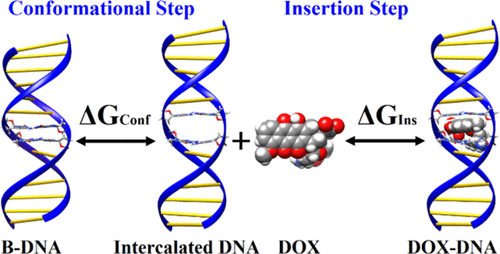当前位置:
X-MOL 学术
›
J. Phys. Chem. B
›
论文详情
Our official English website, www.x-mol.net, welcomes your feedback! (Note: you will need to create a separate account there.)
Thermodynamic Dissection of the Intercalation Binding Process of Doxorubicin to dsDNA with Implications of Ionic and Solvent Effects.
The Journal of Physical Chemistry B ( IF 3.3 ) Pub Date : 2020-08-13 , DOI: 10.1021/acs.jpcb.0c05840 Bahaa Jawad 1, 2 , Lokendra Poudel 3 , Rudolf Podgornik 4, 5, 6 , Wai-Yim Ching 1
The Journal of Physical Chemistry B ( IF 3.3 ) Pub Date : 2020-08-13 , DOI: 10.1021/acs.jpcb.0c05840 Bahaa Jawad 1, 2 , Lokendra Poudel 3 , Rudolf Podgornik 4, 5, 6 , Wai-Yim Ching 1
Affiliation

|
Doxorubicin (DOX) is a cancer drug that binds to dsDNA through intercalation. A comprehensive microsecond timescale molecular dynamics study is performed for DOX with 16 tetradecamer dsDNA sequences in explicit aqueous solvent, in order to investigate the intercalation process at both binding stages (conformational change and insertion binding stages). The molecular mechanics generalized Born surface area (MM-GBSA) method is adapted to quantify and break down the binding free energy (BFE) into its thermodynamic components, for a variety of different solution conditions as well as different DNA sequences. Our results show that the van der Waals interaction provides the largest contribution to the BFE at each stage of binding. The sequence selectivity depends mainly on the base pairs located downstream from the DOX intercalation site, with a preference for (AT)2 or (TA)2 driven by the favorable electrostatic and/or van der Waals interactions. Invoking the quartet sequence model proved to be most successful to predict the sequence selectivity. Our findings also indicate that the aqueous bathing solution (i.e., water and ions) opposes the formation of the DOX–DNA complex at every binding stage, thus implying that the complexation process preferably occurs at low ionic strength and is crucially dependent on solvent effects.
中文翻译:

阿霉素与dsDNA的嵌入结合过程的热力学解剖,涉及离子和溶剂效应。
阿霉素(DOX)是一种通过插入与dsDNA结合的抗癌药物。为了研究在两个显性结合阶段(构象变化和插入结合阶段)的嵌入过程,对具有16个tetradecamer dsDNA序列的DOX进行了全面的微秒时标分子动力学研究。分子力学广义玻恩表面积(MM-GBSA)方法适用于定量和分解结合自由能(BFE)并将其分解为热力学成分,适用于各种不同的溶液条件以及不同的DNA序列。我们的结果表明,范德华相互作用在结合的每个阶段对BFE的贡献最大。序列选择性主要取决于位于DOX插入位点下游的碱基对,由有利的静电和/或范德华相互作用驱动的图2或(TA)2。事实证明,调用四重奏序列模型是预测序列选择性的最成功方法。我们的发现还表明,水性浴液(即水和离子)在每个结合阶段都反对DOX-DNA复合物的形成,因此暗示了复合过程优选在低离子强度下发生,并且关键取决于溶剂的作用。
更新日期:2020-09-10
中文翻译:

阿霉素与dsDNA的嵌入结合过程的热力学解剖,涉及离子和溶剂效应。
阿霉素(DOX)是一种通过插入与dsDNA结合的抗癌药物。为了研究在两个显性结合阶段(构象变化和插入结合阶段)的嵌入过程,对具有16个tetradecamer dsDNA序列的DOX进行了全面的微秒时标分子动力学研究。分子力学广义玻恩表面积(MM-GBSA)方法适用于定量和分解结合自由能(BFE)并将其分解为热力学成分,适用于各种不同的溶液条件以及不同的DNA序列。我们的结果表明,范德华相互作用在结合的每个阶段对BFE的贡献最大。序列选择性主要取决于位于DOX插入位点下游的碱基对,由有利的静电和/或范德华相互作用驱动的图2或(TA)2。事实证明,调用四重奏序列模型是预测序列选择性的最成功方法。我们的发现还表明,水性浴液(即水和离子)在每个结合阶段都反对DOX-DNA复合物的形成,因此暗示了复合过程优选在低离子强度下发生,并且关键取决于溶剂的作用。



























 京公网安备 11010802027423号
京公网安备 11010802027423号